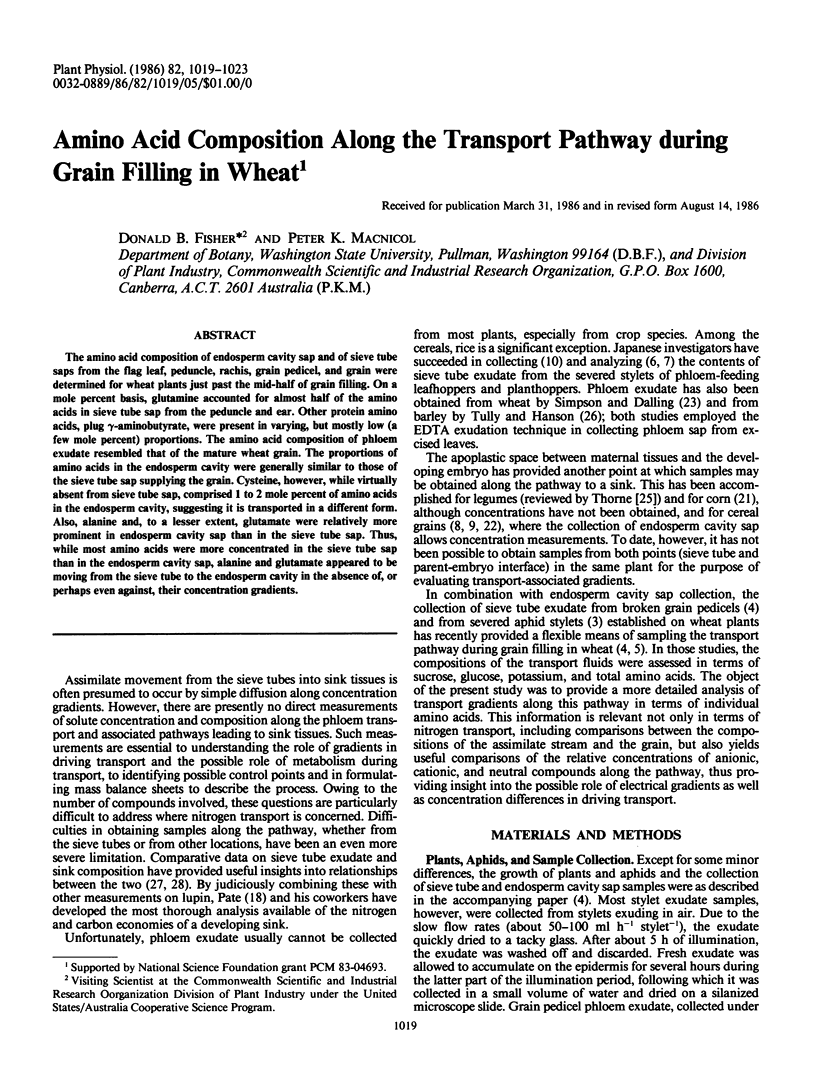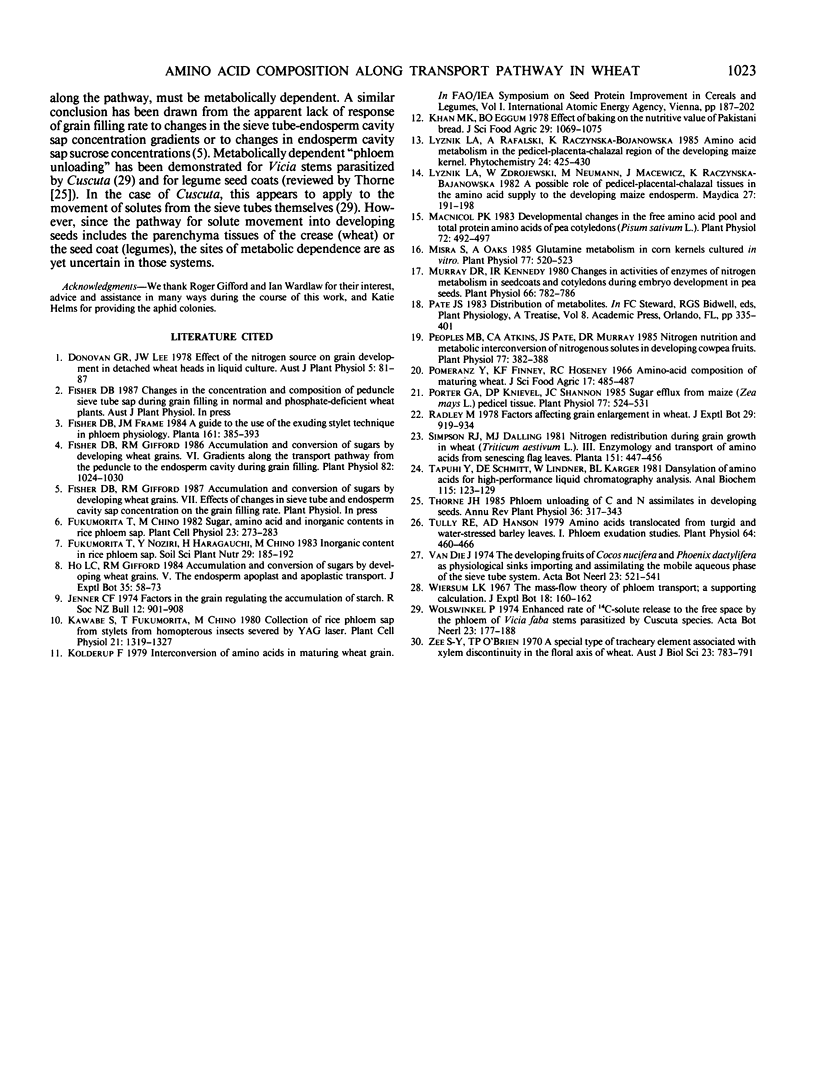Abstract
The amino acid composition of endosperm cavity sap and of sieve tube saps from the flag leaf, peduncle, rachis, grain pedicel, and grain were determined for wheat plants just past the mid-half of grain filling. On a mole percent basis, glutamine accounted for almost half of the amino acids in sieve tube sap from the peduncle and ear. Other protein amino acids, plug γ-aminobutyrate, were present in varying, but mostly low (a few mole percent) proportions. The amino acid composition of phloem exudate resembled that of the mature wheat grain. The proportions of amino acids in the endosperm cavity were generally similar to those of the sieve tube sap supplying the grain. Cysteine, however, while virtually absent from sieve tube sap, comprised 1 to 2 mole percent of amino acids in the endosperm cavity, suggesting it is transported in a different form. Also, alanine and, to a lesser extent, glutamate were relatively more prominent in endosperm cavity sap than in the sieve tube sap. Thus, while most amino acids were more concentrated in the sieve tube sap than in the endosperm cavity sap, alanine and glutamate appeared to be moving from the sieve tube to the endosperm cavity in the absence of, or perhaps even against, their concentration gradients.
Full text
PDF




Selected References
These references are in PubMed. This may not be the complete list of references from this article.
- Fisher D. B., Gifford R. M. Accumulation and Conversion of Sugars by Developing Wheat Grains : VI. Gradients Along the Transport Pathway from the Peduncle to the Endosperm Cavity during Grain Filling. Plant Physiol. 1986 Dec;82(4):1024–1030. doi: 10.1104/pp.82.4.1024. [DOI] [PMC free article] [PubMed] [Google Scholar]
- Khan M. A., Eggum B. O. Effect of baking on the nutritive value of Pakistani bread. J Sci Food Agric. 1978 Dec;29(12):1069–1075. doi: 10.1002/jsfa.2740291212. [DOI] [PubMed] [Google Scholar]
- Macnicol P. K. Developmental Changes in the Free Amino Acid Pool and Total Protein Amino Acids of Pea Cotyledons (Pisum sativum L.). Plant Physiol. 1983 Jun;72(2):492–497. doi: 10.1104/pp.72.2.492. [DOI] [PMC free article] [PubMed] [Google Scholar]
- Misra S., Oaks A. Glutamine metabolism in corn kernels cultured in vitro. Plant Physiol. 1985 Mar;77(3):520–523. doi: 10.1104/pp.77.3.520. [DOI] [PMC free article] [PubMed] [Google Scholar]
- Murray D. R. Changes in Activities of Enzymes of Nitrogen Metabolism in Seedcoats and Cotyledons during Embryo Development in Pea Seeds. Plant Physiol. 1980 Oct;66(4):782–786. doi: 10.1104/pp.66.4.782. [DOI] [PMC free article] [PubMed] [Google Scholar]
- Peoples M. B., Atkins C. A., Pate J. S., Murray D. R. Nitrogen nutrition and metabolic interconversions of nitrogenous solutes in developing cowpea fruits. Plant Physiol. 1985 Feb;77(2):382–388. doi: 10.1104/pp.77.2.382. [DOI] [PMC free article] [PubMed] [Google Scholar]
- Pomeranz Y., Finney K. F., Hoseney R. C. Amino-acid composition of maturing wheat. J Sci Food Agric. 1966 Nov;17(10):485–487. doi: 10.1002/jsfa.2740171101. [DOI] [PubMed] [Google Scholar]
- Porter G. A., Knievel D. P., Shannon J. C. Sugar Efflux from Maize (Zea mays L.) Pedicel Tissue. Plant Physiol. 1985 Mar;77(3):524–531. doi: 10.1104/pp.77.3.524. [DOI] [PMC free article] [PubMed] [Google Scholar]
- Tapuhi Y., Schmidt D. E., Lindner W., Karger B. L. Dansylation of amino acids for high-performance liquid chromatography analysis. Anal Biochem. 1981 Jul 15;115(1):123–129. doi: 10.1016/0003-2697(81)90534-0. [DOI] [PubMed] [Google Scholar]
- Tully R. E., Hanson A. D. Amino Acids Translocated from Turgid and Water-stressed Barley Leaves: I. Phloem Exudation Studies. Plant Physiol. 1979 Sep;64(3):460–466. doi: 10.1104/pp.64.3.460. [DOI] [PMC free article] [PubMed] [Google Scholar]


